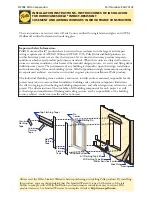
day, it isn’t going to last over the
esign flow’. To lower flows, ins
long haul. Ideal flows are 60-70% of your stated
tall low-flow fixtures and monitor employee
Cleaners
ld. This at best causes the system to
tenance of grease traps. By
ce the burden
.
Dry-wipe pots, pans and dishes before washing them. Dispose of wastes in
nd grease under fryer baskets.
s
the
Clean grease traps regularly and keep records. If grease level is at the max,
out frequency. If grease levels are minimal, reduce frequency.
•
Witness cleaning and maintenance events. Ensure they are performed
‘d
habits to cut down on waste. Turn off drip water to pea-traps, route ice machine
water to outside drains and do laundry off-site. Figure out everywhere water is
eing used and cut it back to the maximum extent possible.
b
asy on the
E
Excessive cleaning is often required in commercial operations. Try to use less
abrasive chemicals and cleaners if possible and always try to use minimal
amounts. High amounts of harsh chemicals and cleaners end up killing the
elpful bacteria in the tanks and drainfie
h
operate inefficiently. At worst, it will destroy the system and you’ll find yourself
with a costly repair.
Cut Through the FOG
OG – fat (and food), oil and grease – can be managed to minimize the
F
discharge to the septic system and decrease main
reventing the introduction of FOG into the septic system you redu
p
on the grease traps and reduce maintenance time, costs and disposal fees
Cleanup Tips:
•
Use rubber scrapers to remove FOG from cookware, utensils, chafing dishes
and serving ware. Disposing of grease by recycling or in the garbage is
cheaper than frequent tank pumping.
•
the trash, not the sink! Extra solids create high-strength waste.
•
Use absorbent material to soak up oil a
•
Use paper towels to wipe down pots, pans, machines, work areas, etc. Cloth
towels will accumulate grease and oil that will eventually end up in your drain
from doing laundry.
•
Place drain screens in all sinks and floor drains. Dump these solids in the
trash.
•
Get rid of garbage disposals – they create high-strength waste and cause
tanks to fill with solids faster, costing you more money for pumping.
•
Keep water temperature in sinks at 140 degrees F or below.
•
Post “NO GREASE” signs at appropriate locations such as above sink drains.
•
Train kitchen staff in management practices and methods to reduce the
volume of grease discharged to the septic system.
•
increase clean
completely and properly. Ensure all solids are removed during pumping and
make sure components are put back together correctly when finished.
- 58 -
Содержание Septic System
Страница 2: ...This page intentionally left blank ...























